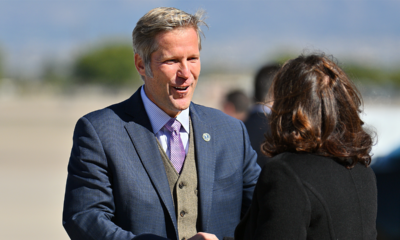Business
Would breaking up Live Nation and Ticketmaster actually lower concert ticket prices?

The U.S. Department of Justice’s effort to break up Live Nation and Ticketmaster has been a long time coming, following years of complaints from concertgoers who say they’ve been squeezed by exorbitant prices and hidden fees when trying to buy passes to see Taylor Swift, Beyoncé and other music megastars.
Ever since the government cleared the merger of concert promoter Live Nation and ticketseller Ticketmaster in 2010, there have been demands from consumer advocates to cleave them. The Justice Department argues that the combination is a monopoly that has resulted in harm for music fans and has clamped down competition in the multibillion-dollar live music market.
Live Nation says the arguments are off-base and will probably fail in court. Either way, it will take a long time for the case to wind through the legal system.
Why is the government suing Live Nation?
The Justice Department has raised concerns that Live Nation and Ticketmaster have retaliated against competitors and new entrants and locked out competition with exclusionary contracts.
“The result is that fans pay more in fees, artists have fewer opportunities to play concerts, smaller promoters get squeezed out, and venues have fewer real choices for ticketing services,” said Atty. Gen. Merrick B. Garland. “It is time to break up Live Nation-Ticketmaster.”
Beverly Hills-based Live Nation, the world’s largest concert company, has long been a target for government scrutiny.
When the U.S. approved the 2010 merger, it did so after the companies agreed to a settlement meant to ensure fair competition in the ticketing marketplace and prohibit Live Nation from retaliating against venue owners that decided to defect to competitors. The consent decree was extended and amended in 2019.
But this time, the government is going hard at the company. In its Thursday lawsuit, the U.S. accused Live Nation of various anticompetitive practices and said the company uses its market dominance to impose fees on consumers and pressure artists to use its services.
The suit comes amid a wave of antitrust action from the Biden administration, which has sought to curb the power of conglomerates and Big Tech. The U.S. government has filed other cases against tech giants including Apple, Amazon and Google, taking them to task for their alleged impact on competition.
Live Nation said that the lawsuit will not solve issues related to ticket prices, service fees or access to in-demand shows.
“Calling Ticketmaster a monopoly may be a PR win for the DOJ in the short term, but it will lose in court because it ignores the basic economics of live entertainment, such as the fact that the bulk of service fees go to venues, and that competition has steadily eroded Ticketmaster’s market share and profit margin,” Live Nation said in a statement.
Would breaking up Live Nation lower prices?
Several industry observers who spoke to The Times expressed doubt that the lawsuit would significantly reduce prices for consumers.
Brandon Ross, an analyst at research firm LightShed Partners, said that artists decide how much they want to charge for a tour and then the promoter buys the tour from them. Due to Live Nation’s large scale, it is able to take a lower profit margin, with most of the money going back to the artist, Ross added.
“There is an efficiency in having a large player in the industry,” Ross said. “If that goes away, then that’s going to come out of either the artist’s take, or the artists are going to charge consumers even more.”
Artists like Swift and Bruce Springsteen are able to charge big sums for tickets because the concerts are one-time events, and some people are willing to pay. Because of supply and demand, tickets resold on the secondary market can be much higher than face value.
But James Sammataro, co-chair of Pryor Cashman’s music group, said he believes the lawsuit could address issues such as excess ticketing fees.
“What’s really harming the consumer is all these excess fees and the restrictions on getting the tickets,” Sammataro said. “For most artists, these ‘increased prices’ aren’t really benefiting the artists. In many cases, it’s alienating their core ticket buyers and their core audience.”
There is a larger issue in the music industry of concert tickets being bought at face value by scalpers and resold on secondary markets for astronomical prices.
It’s leading to two classes of music fans: those who can afford to pony up and those who can’t.
Meanwhile, many promoters left the industry after getting clobbered by the pandemic, which shut down or restricted many live events. Some smaller music artists have also been hurt by the lack of competition among promoters and are not given opportunities to play at larger venues, Sammataro said.
“The overall effect is that it leads to a very tilted playing field where it’s difficult for promoters to compete,” Sammataro said. “And when you have a lack of competition, essentially like the basis of predatory pricing, ultimately there’s going to be long term gouging.”
Could the company actually be broken up?
Anything is possible, but there is one thing everyone agrees on: This legal battle will be a long fight.
“Antitrust litigation can be long and protracted,” said Eric Enson, an antitrust partner at Crowell & Moring. “I expect that this will be a matter of years and not months.”
Music industry expert Bill Werde, who runs the music business program at Syracuse University, cautioned that splitting up such a large enterprise wouldn’t be easy, and it’s unclear what the businesses would look like after being disentangled from one another more than a decade after merging.
“They make their margin in ticketing and sponsorships, so if you break up this company, … I don’t know how Live Nation the concert promotion business necessarily lives and thrives independent of this high-margin ticketing business,” said Werde, who also publishes a weekly newsletter.
But even if it could lose, there are reasons the government might be motivated to go after the company in an election year. As Werde and other experts were quick to point out, there’s nothing that unites people like hating Ticketmaster.

Business
U.S. Space Force awards $1.6 billion in contracts to South Bay satellite builders

The U.S. Space Force announced Friday it has awarded satellite contracts with a combined value of about $1.6 billion to Rocket Lab in Long Beach and to the Redondo Beach Space Park campus of Northrop Grumman.
The contracts by the Space Development Agency will fund the construction by each company of 18 satellites for a network in development that will provide warning of advanced threats such as hypersonic missiles.
Northrop Grumman has been awarded contracts for prior phases of the Proliferated Warfighter Space Architecture, a planned network of missile defense and communications satellites in low Earth orbit.
The contract announced Friday is valued at $764 million, and the company is now set to deliver a total of 150 satellites for the network.
The $805-million contract awarded to Rocket Lab is its largest to date. It had previously been awarded a $515 million contract to deliver 18 communications satellites for the network.
Founded in 2006 in New Zealand, the company builds satellites and provides small-satellite launch services for commercial and government customers with its Electron rocket. It moved to Long Beach in 2020 from Huntington Beach and is developing a larger rocket.
“This is more than just a contract. It’s a resounding affirmation of our evolution from simply a trusted launch provider to a leading vertically integrated space prime contractor,” said Rocket Labs founder and chief executive Peter Beck in online remarks.
The company said it could eventually earn up to $1 billion due to the contract by supplying components to other builders of the satellite network.
Also awarded contracts announced Friday were a Lockheed Martin group in Sunnyvalle, Calif., and L3Harris Technologies of Fort Wayne, Ind. Those contracts for 36 satellites were valued at nearly $2 billion.
Gurpartap “GP” Sandhoo, acting director of the Space Development Agency, said the contracts awarded “will achieve near-continuous global coverage for missile warning and tracking” in addition to other capabilities.
Northrop Grumman said the missiles are being built to respond to the rise of hypersonic missiles, which maneuver in flight and require infrared tracking and speedy data transmission to protect U.S. troops.
Beck said that the contracts reflects Rocket Labs growth into an “industry disruptor” and growing space prime contractor.
Business
California-based company recalls thousands of cases of salad dressing over ‘foreign objects’

A California food manufacturer is recalling thousands of cases of salad dressing distributed to major retailers over potential contamination from “foreign objects.”
The company, Irvine-based Ventura Foods, recalled 3,556 cases of the dressing that could be contaminated by “black plastic planting material” in the granulated onion used, according to an alert issued by the U.S. Food and Drug Administration.
Ventura Foods voluntarily initiated the recall of the product, which was sold at Costco, Publix and several other retailers across 27 states, according to the FDA.
None of the 42 locations where the product was sold were in California.
Ventura Foods said it issued the recall after one of its ingredient suppliers recalled a batch of onion granules that the company had used n some of its dressings.
“Upon receiving notice of the supplier’s recall, we acted with urgency to remove all potentially impacted product from the marketplace. This includes urging our customers, their distributors and retailers to review their inventory, segregate and stop the further sale and distribution of any products subject to the recall,” said company spokesperson Eniko Bolivar-Murphy in an emailed statement. “The safety of our products is and will always be our top priority.”
The FDA issued its initial recall alert in early November. Costco also alerted customers at that time, noting that customers could return the products to stores for a full refund. The affected products had sell-by dates between Oct. 17 and Nov. 9.
The company recalled the following types of salad dressing:
- Creamy Poblano Avocado Ranch Dressing and Dip
- Ventura Caesar Dressing
- Pepper Mill Regal Caesar Dressing
- Pepper Mill Creamy Caesar Dressing
- Caesar Dressing served at Costco Service Deli
- Caesar Dressing served at Costco Food Court
- Hidden Valley, Buttermilk Ranch
Business
They graduated from Stanford. Due to AI, they can’t find a job

A Stanford software engineering degree used to be a golden ticket. Artificial intelligence has devalued it to bronze, recent graduates say.
The elite students are shocked by the lack of job offers as they finish studies at what is often ranked as the top university in America.
When they were freshmen, ChatGPT hadn’t yet been released upon the world. Today, AI can code better than most humans.
Top tech companies just don’t need as many fresh graduates.
“Stanford computer science graduates are struggling to find entry-level jobs” with the most prominent tech brands, said Jan Liphardt, associate professor of bioengineering at Stanford University. “I think that’s crazy.”
While the rapidly advancing coding capabilities of generative AI have made experienced engineers more productive, they have also hobbled the job prospects of early-career software engineers.
Stanford students describe a suddenly skewed job market, where just a small slice of graduates — those considered “cracked engineers” who already have thick resumes building products and doing research — are getting the few good jobs, leaving everyone else to fight for scraps.
“There’s definitely a very dreary mood on campus,” said a recent computer science graduate who asked not to be named so they could speak freely. “People [who are] job hunting are very stressed out, and it’s very hard for them to actually secure jobs.”
The shake-up is being felt across California colleges, including UC Berkeley, USC and others. The job search has been even tougher for those with less prestigious degrees.
Eylul Akgul graduated last year with a degree in computer science from Loyola Marymount University. She wasn’t getting offers, so she went home to Turkey and got some experience at a startup. In May, she returned to the U.S., and still, she was “ghosted” by hundreds of employers.
“The industry for programmers is getting very oversaturated,” Akgul said.
The engineers’ most significant competitor is getting stronger by the day. When ChatGPT launched in 2022, it could only code for 30 seconds at a time. Today’s AI agents can code for hours, and do basic programming faster with fewer mistakes.
Data suggests that even though AI startups like OpenAI and Anthropic are hiring many people, it is not offsetting the decline in hiring elsewhere. Employment for specific groups, such as early-career software developers between the ages of 22 and 25 has declined by nearly 20% from its peak in late 2022, according to a Stanford study.
It wasn’t just software engineers, but also customer service and accounting jobs that were highly exposed to competition from AI. The Stanford study estimated that entry-level hiring for AI-exposed jobs declined 13% relative to less-exposed jobs such as nursing.
In the Los Angeles region, another study estimated that close to 200,000 jobs are exposed. Around 40% of tasks done by call center workers, editors and personal finance experts could be automated and done by AI, according to an AI Exposure Index curated by resume builder MyPerfectResume.
Many tech startups and titans have not been shy about broadcasting that they are cutting back on hiring plans as AI allows them to do more programming with fewer people.
Anthropic Chief Executive Dario Amodei said that 70% to 90% of the code for some products at his company is written by his company’s AI, called Claude. In May, he predicted that AI’s capabilities will increase until close to 50% of all entry-level white-collar jobs might be wiped out in five years.
A common sentiment from hiring managers is that where they previously needed ten engineers, they now only need “two skilled engineers and one of these LLM-based agents,” which can be just as productive, said Nenad Medvidović, a computer science professor at the University of Southern California.
“We don’t need the junior developers anymore,” said Amr Awadallah, CEO of Vectara, a Palo Alto-based AI startup. “The AI now can code better than the average junior developer that comes out of the best schools out there.”
To be sure, AI is still a long way from causing the extinction of software engineers. As AI handles structured, repetitive tasks, human engineers’ jobs are shifting toward oversight.
Today’s AIs are powerful but “jagged,” meaning they can excel at certain math problems yet still fail basic logic tests and aren’t consistent. One study found that AI tools made experienced developers 19% slower at work, as they spent more time reviewing code and fixing errors.
Students should focus on learning how to manage and check the work of AI as well as getting experience working with it, said John David N. Dionisio, a computer science professor at LMU.
Stanford students say they are arriving at the job market and finding a split in the road; capable AI engineers can find jobs, but basic, old-school computer science jobs are disappearing.
As they hit this surprise speed bump, some students are lowering their standards and joining companies they wouldn’t have considered before. Some are creating their own startups. A large group of frustrated grads are deciding to continue their studies to beef up their resumes and add more skills needed to compete with AI.
“If you look at the enrollment numbers in the past two years, they’ve skyrocketed for people wanting to do a fifth-year master’s,” the Stanford graduate said. “It’s a whole other year, a whole other cycle to do recruiting. I would say, half of my friends are still on campus doing their fifth-year master’s.”
After four months of searching, LMU graduate Akgul finally landed a technical lead job at a software consultancy in Los Angeles. At her new job, she uses AI coding tools, but she feels like she has to do the work of three developers.
Universities and students will have to rethink their curricula and majors to ensure that their four years of study prepare them for a world with AI.
“That’s been a dramatic reversal from three years ago, when all of my undergraduate mentees found great jobs at the companies around us,” Stanford’s Liphardt said. “That has changed.”
-

 Iowa6 days ago
Iowa6 days agoAddy Brown motivated to step up in Audi Crooks’ absence vs. UNI
-

 Iowa1 week ago
Iowa1 week agoHow much snow did Iowa get? See Iowa’s latest snowfall totals
-

 Maine4 days ago
Maine4 days agoElementary-aged student killed in school bus crash in southern Maine
-

 Maryland6 days ago
Maryland6 days agoFrigid temperatures to start the week in Maryland
-

 Technology1 week ago
Technology1 week agoThe Game Awards are losing their luster
-

 South Dakota6 days ago
South Dakota6 days agoNature: Snow in South Dakota
-

 New Mexico4 days ago
New Mexico4 days agoFamily clarifies why they believe missing New Mexico man is dead
-

 Nebraska1 week ago
Nebraska1 week agoNebraska lands commitment from DL Jayden Travers adding to early Top 5 recruiting class




















